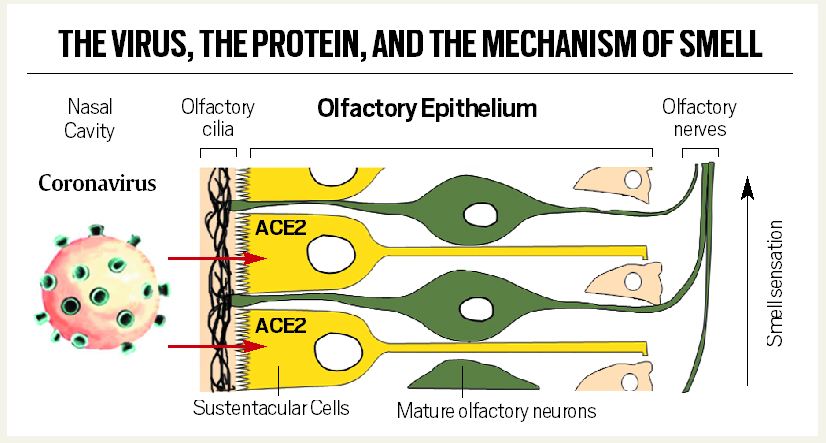 Nasal swab being collected. (PTI Photo/File)
Nasal swab being collected. (PTI Photo/File)
Loss of the sense of smell (and taste), one of the more recently identified symptoms of Covid-19, is now recognised as such by the World Health Organization (WHO) and the health authorities of some countries, including the US. A new study in mice has sought to explore why this symptom appears in some Covid-19 patients. They have reported their findings in the American Chemical Society’s journal ACS Chemical Neuroscience.
Tracking the proteins
SARS-CoV-2, the virus that causes Covid-19, hijacks two human proteins to invade cells. One is the ACE2 “receptor” on the cell surface (it opens the door for the virus) while the other is called TMPRSS2, which the virus uses to replicate its genetic material.
Explained: How Covid-19 affects different parts of the body
In mice, the researchers found, these two proteins are produced by certain cells of the nasal cavity that contribute to the mice’s sense of smell (and ours). Within the olfactory epithelium, which is a tissue lining the nasal cavity that is involved in smell, the “sustentacular cells” had the highest level of SARS-CoV-2 receptors, researcher Rafal Butowt of Nicolaus Copernicus University, Poland, told The Indian Express by email.
The sustentacular cells help transfer odours from the air to neurons.
Butowt and colleagues first used various methods to measure the levels of expression of the two proteins. They found that the mature olfactory neurons do not express ACE2, while the sustentacular cells do.
📣 Express Explained is now on Telegram. Click here to join our channel (@ieexplained) and stay updated with the latest
“The sense of smell in Covid-19 patients appears to be lost, because the sustentacular cells assist neurons in sensing odours, probably by processing odour-binding proteins,” Butowt said.
Identifying these cells could help in the development of more accurate diagnostic tests, the researchers said. They have called for future studies should examine whether sustentacular cells can pass the virus to neurons, which could provide SARS-CoV-2 a route to infect the brain.
 The novel coronavirus uses ACE2 receptors to enter sustentacular cells in the olfactory epithelium. The mature olfactory neurons do not express ACE2. (Source: Butowt et al, ACS Chemical Neuroscience)
The novel coronavirus uses ACE2 receptors to enter sustentacular cells in the olfactory epithelium. The mature olfactory neurons do not express ACE2. (Source: Butowt et al, ACS Chemical Neuroscience)
Age is a factor
The researchers also found that larger amounts of the proteins are made in older mice than in younger ones. “These are significant findings, because the more entry proteins a host cell has, the easier it is for the virus to bind, enter and infect that cell. The high levels of entry proteins in the nasal epithelium may explain why older humans are more likely to become infected with the novel coronavirus than younger humans,” Butowt said.
The question is whether what was observed in mice happens in humans too. “It is known that the entry proteins have similar expression patterns among mammalian species — meaning that the mouse appears to be suitable model for the human condition,” Butowt said.
Why the nose matters
Earlier research (The Indian Express, April 29) had identified two kinds of cells in the nose as the likely first entry points for the virus. These are goblet cells (which produce mucus) and ciliated cells (which help sweep mucus to the throat so it can be swallowed).
Read | What parents should know about COVID-19 symptoms in children
That study, too, had drawn its conclusions from the expression of the two entry proteins. Using the Human Cell Atlas database, it looked at data from different tissues of non-infected people. It found that these two proteins had the highest presence in goblet and ciliated cells.
There is a key difference in what the two studies looked at. The previous study, by researchers of UK’s Wellcome Sangner Institute, looked at all human cells and identified goblet and ciliated cells as the likely first points of entry. These occur in the respiratory epithelium, while the new study looked specifically at the olfactory epithelium.
Explained | Strokes in Covid-19 patients: Four studies capture trends
Asked if the findings are in conflict, Butowt said all studies depend on the method used. “However what is sure is that sustentacular cells in the olfactory epithelium have highest level of SARS-CoV-2 receptors as compared to other cells in olfactory epithelium, and ciliary and goblet cells I may say the same as compared to other cells in the respiratory epithelium. But direct comparison between respiratory and olfactory epithelium requires further studies with more techniques,” Butowt said.
“… There are few studies now, and some require further examinations to resolve inconsistencies between the results. That is how real science works I think.”
📣 The Indian Express is now on Telegram. Click here to join our channel (@indianexpress) and stay updated with the latest headlines
For all the latest Explained News, download Indian Express App.
"smell" - Google News
May 28, 2020 at 09:12AM
https://ift.tt/2XzP5kt
Explained: Why do some Covid-19 patients lose their sense of smell? - The Indian Express
"smell" - Google News
https://ift.tt/35zrwu1
https://ift.tt/3b8aPsv
Bagikan Berita Ini

















0 Response to "Explained: Why do some Covid-19 patients lose their sense of smell? - The Indian Express"
Post a Comment